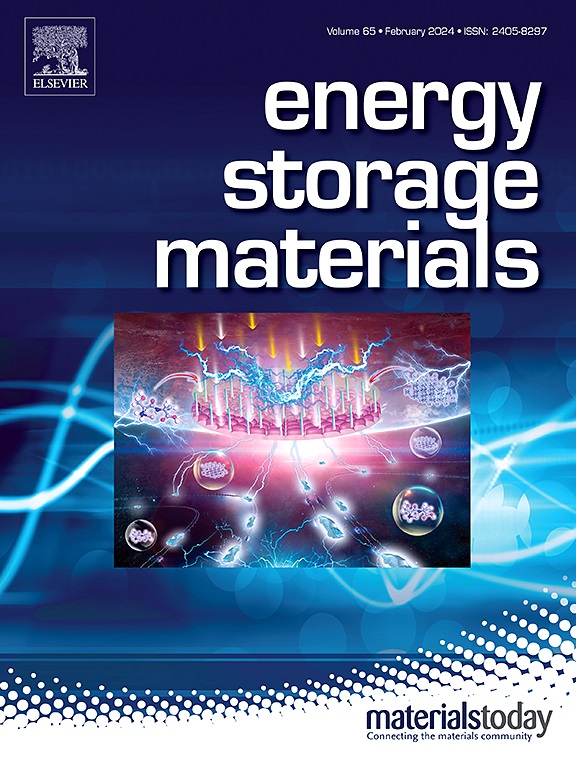高性能锂硫电池双原子位的协同催化活性和电子结构调整
IF 18.9
1区 材料科学
Q1 CHEMISTRY, PHYSICAL
引用次数: 0
摘要
锂多硫化物(LiPSs)缓慢的氧化还原动力学和Li2S沉积/解离的高能量势垒被认为是阻碍锂硫(li -硫)电池实现的两个重大挑战。在本研究中,我们筛选并成功合成了Fe-Cu和Co-Cu双原子负载的还原氧化石墨烯(rGO)催化材料,该材料对LiPSs具有协同催化活性,有利于Li2S电子结构的调整。因此,硫阴极与Fe-Cu dual-atomic催化剂网站展现非凡的电化学性能,包括高初始容量的1164 mAh g−1 0.2 C,一个出色的额定容量的625.2 mAh克−1在5度左右,和优秀的周期稳定的低容量衰减率0.045%周期超过500个周期在1 C。值得注意的是,即使有高硫加载(8.5毫克厘米−2)和低E / S比值(6μL mg−1),一个令人印象深刻的初始容量的7.33 mAh厘米−2。此外,锂- s袋电池在0.2℃下具有5.5 mAh cm - 2的高放电容量,并且在100次循环后容量保持率为82%。这些结果突出了元素选择和双原子催化材料协同作用在推动锂硫电池硫氧化还原动力学中的重要性。本文章由计算机程序翻译,如有差异,请以英文原文为准。

Synergizing catalytic activity and electronic structure adjustment by dual-atomic sites for high-performance lithium–sulfur batteries
The slow redox kinetics of lithium polysulfides (LiPSs) and the high energy barrier for Li2S deposition/dissociation are considered two significant challenges impeding the implementation of lithium–sulfur (Li–S) batteries. In this study, we have screened and successfully synthesized Fe-Cu and Co-Cu dual-atomic catalytic materials supported on reduced graphene oxide (rGO), which exhibits synergistic catalytic activity towards LiPSs and facilitates the adjustment of the electronic structure of Li2S. Consequently, the sulfur cathode with Fe-Cu dual-atomic catalyst sites exhibits remarkable electrochemical performance, including a high initial capacity of 1164 mAh g−1 at 0.2 C, an exceptional rate capacity of 625.2 mAh g−1 at 5 C, and excellent cycle stability with a low capacity fading rate of 0.045 % per cycle over 500 cycles at 1 C. Notably, even with a high sulfur loading (8.5 mg cm−2) and a low E/S ratio (6 μL mg−1), an impressive initial capacity of 7.33 mAh cm−2 is achieved. Furthermore, the Li–S pouch cell demonstrates a high discharge capacity of 5.5 mAh cm−2 at 0.2 C, along with a capacity retention of 82 % after 100 cycles. These results highlight the importance of elemental choice and synergy of dual-atomic catalytic materials in substantially propelling the sulfur redox kinetics in Li–S batteries.
求助全文
通过发布文献求助,成功后即可免费获取论文全文。
去求助
来源期刊

Energy Storage Materials
Materials Science-General Materials Science
CiteScore
33.00
自引率
5.90%
发文量
652
审稿时长
27 days
期刊介绍:
Energy Storage Materials is a global interdisciplinary journal dedicated to sharing scientific and technological advancements in materials and devices for advanced energy storage and related energy conversion, such as in metal-O2 batteries. The journal features comprehensive research articles, including full papers and short communications, as well as authoritative feature articles and reviews by leading experts in the field.
Energy Storage Materials covers a wide range of topics, including the synthesis, fabrication, structure, properties, performance, and technological applications of energy storage materials. Additionally, the journal explores strategies, policies, and developments in the field of energy storage materials and devices for sustainable energy.
Published papers are selected based on their scientific and technological significance, their ability to provide valuable new knowledge, and their relevance to the international research community.
 求助内容:
求助内容: 应助结果提醒方式:
应助结果提醒方式:


